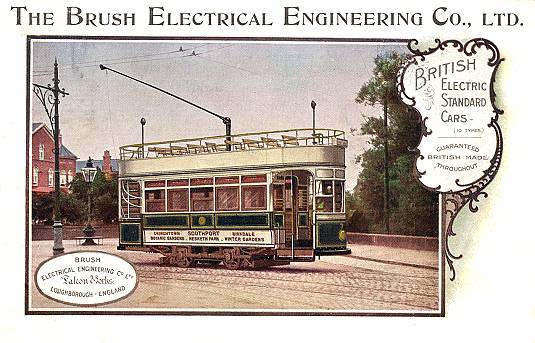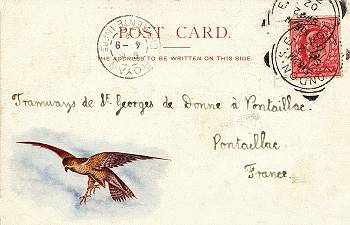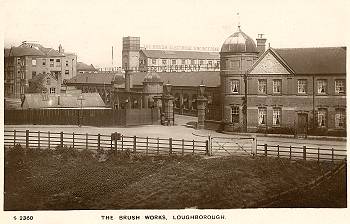

This unusual postcard is an advertising card from The Brush Electrical Engineering Co. Ltd. sent on 2nd September 1902 from London SE to the Tramway Saint Georges de Didonne à Pontaillac, (misspelt on the card's address), a steam line that ran through Royan in France and who had probably been a customer for rolling stock from Brush's predecessor, the Falcon Engine and Car Works Ltd. The tram on the postcard is one of twenty built for the Southport Tramways Company Ltd. in 1901. The small view below is the address side of the card which as can be seen has an undivided back and carries the falcon emblem of the Brush Company. The card also has a 'perfin' stamp, i.e. a letter B has been perforated through the centre. In this case, B would indicate Brush, the idea being that employees wouldn't steal stamps from their employer for their own personal use. The final small view is of Brush's Falcon Works at Loughborough. It's from a postcard by WH Smith in their 'Kingsway Real Photo Series', produced about 1910.
 The Brush Electrical Engineering Company was one of the largest producers of tramcars in Britain, second only to Dick, Kerr and its associates and successors at Preston. It was also probably the largest producer of tramcar trucks. Charles Francis Brush was born in Cleveland Ohio in the US on 17th March 1848. In 1877 he invented a very effective system of generators and arc lamps for lighting. In the UK the Anglo-American Brush Electric Light Co. Ltd. was established 1n 1879 and set up the Victoria Works at 112 Belvedere Road in Lambeth, London SE1, near where the "London Eye" is now situated. The "Brush Electrical Engineering Company" name was used from 1889 and had a head office address at 42 Queen Victoria Street, London EC4. In the same year Brush took over the Falcon Engine and Car Works Ltd. and set up its tramcar business in the Falcon Works at Loughborough, adopting the falcon at its business emblem. The Falcon Works itself dates back to 1865 when Henry Hughes began building locomotives and rolling stock there, later steam trams, trailers and horse trams. In Brush days the works produced all the parts for an electric tramcar, bodies, trucks, motors, controllers etc.
The Brush Electrical Engineering Company was one of the largest producers of tramcars in Britain, second only to Dick, Kerr and its associates and successors at Preston. It was also probably the largest producer of tramcar trucks. Charles Francis Brush was born in Cleveland Ohio in the US on 17th March 1848. In 1877 he invented a very effective system of generators and arc lamps for lighting. In the UK the Anglo-American Brush Electric Light Co. Ltd. was established 1n 1879 and set up the Victoria Works at 112 Belvedere Road in Lambeth, London SE1, near where the "London Eye" is now situated. The "Brush Electrical Engineering Company" name was used from 1889 and had a head office address at 42 Queen Victoria Street, London EC4. In the same year Brush took over the Falcon Engine and Car Works Ltd. and set up its tramcar business in the Falcon Works at Loughborough, adopting the falcon at its business emblem. The Falcon Works itself dates back to 1865 when Henry Hughes began building locomotives and rolling stock there, later steam trams, trailers and horse trams. In Brush days the works produced all the parts for an electric tramcar, bodies, trucks, motors, controllers etc.
 A number of early Brush company employees became important pioneers in British tramways. Emile Garke, born in Saxony in 1856, became company secretary in 1883, manager in 1887 and managing director in 1891. In 1896, together with friends including other Brush directors, he set up the British Electric Traction Co. Ltd. He was chairman of the Metropolitan Electric Tramways from 1902 until 1929 (vice-chairman from 1929). He remained in charge at Brush until his death in 1930. John S. Raworth joined Brush from Siemens in 1886. He went on to design the demi-car and its ingenious system of regenerative braking. Elmer E. Cook joined Brush in 1891 from the Mc.Guire Manufacturing Co. of Chicago, and set up the tramcar truck shop at the Falcon Works. He established for Brush a range of 4-wheel trucks and equal-wheel and maximum traction bogies, some of which were similar to the Mc.Guire designs although the 4-wheel design from 1904 was a close copy of the Brill 21E. Cook returned to the US in 1906.
A number of early Brush company employees became important pioneers in British tramways. Emile Garke, born in Saxony in 1856, became company secretary in 1883, manager in 1887 and managing director in 1891. In 1896, together with friends including other Brush directors, he set up the British Electric Traction Co. Ltd. He was chairman of the Metropolitan Electric Tramways from 1902 until 1929 (vice-chairman from 1929). He remained in charge at Brush until his death in 1930. John S. Raworth joined Brush from Siemens in 1886. He went on to design the demi-car and its ingenious system of regenerative braking. Elmer E. Cook joined Brush in 1891 from the Mc.Guire Manufacturing Co. of Chicago, and set up the tramcar truck shop at the Falcon Works. He established for Brush a range of 4-wheel trucks and equal-wheel and maximum traction bogies, some of which were similar to the Mc.Guire designs although the 4-wheel design from 1904 was a close copy of the Brill 21E. Cook returned to the US in 1906.
Brush continued to produce tramcars and their equipment for British and overseas tramways until 1937, the last being twenty single-deck railcoaches for Blackpool, although they produced bus bodies until 1951, after which only electrical equipment was manufactured at the Falcon Works. Brush, now owned by Melrose plc, still manufactures at Loughborough under the name of Brush Turbogenerators.
![]() Go to Postcard Of The Month Index
Go to Postcard Of The Month Index